Biodiesel Production Using Modified Direct Transesterification by Sequential Use of Acid-Base Catalysis and Performance Evaluation of Diesel Engine Using Various Blends
Abstract
:1. Introduction
2. Materials and Methods
2.1. Production of Biodiesel Using Direct Transesterification (DT)
2.2. Modified Direct Transesterification (MDT)
3. Experimental Procedure and Set Up Used
4. Results and Discussions
4.1. Injector Opening Pressure (IOP) Effect on the CI Engine Performance
Engine Brake Thermal Efficiency
4.2. Number of Nozzle Holes and Their Orifice Diameter Effect on the Diesel Engine Performance
Engine Brake Thermal Efficiency
4.3. CC Shapes Effect on the Performance of Diesel Engine Driven by CPB10 and NSB10
4.3.1. Performance of Engine Brake Thermal Efficiency
4.3.2. Exhaust Emissions
5. Conclusions
- Direct transesterification (DT) can be an optimum solution to the glycerine separation problem. The duration for chemical reaction is considerably reduced from 5 h to only 2 h;
- The modified direct transesterification (MDT) eliminates problems associated with petroleum ether and blending;
- The diesel run engine provided 30.6% BTE at 23° bTDC, 205 bar IOP and HCC at 80% load. The CPB10 fueled diesel engine provided a maximum BTE of 29.1% while the NSB10 fueled engine yielded a BTE of 28.4% with 240 bar IOP, a six-hole injector (0.2 mm orifice diameter) and TRCC shape;
- CO, HC, NOx and smoke for CPB10 were 0.09%, 55 ppm, 1140 ppm and 48 ppm, respectively, whereas for NSB10 they were 0.11%, 59 ppm, 1142 ppm and 52 ppm, respectively, at 23° bTDC of injection timing, 240 bar IOP and 80% load, which are comparable with the diesel run engine at 23° bTDC, 205 bar IOP and at 80% load. CO, HC, NOx and smoke emissions for a diesel fuel engine at stated operating conditions are 0.1%, 40 ppm, 1080 ppm and 44 ppm;
- HRR in the NSB10 run engine was 73 J/° crank angle, the CPB10 run engine was 76 J/°crank angle at 23° bTDC of injection timing, 240 bar IOP and 80% load. Whereas 78 J/°crank angle for diesel engine at 23° bTDC, 205 bar IOP and at 80% load;
- The maximum combustion pressure inside the cylinder for CPB10 was 72 bar and NSB10 was 70 bar at 23° bTDC, 240 bar IOP and at 80% load. Whereas for diesel it was 75 bar at 23° bTDC, 205 bar IOP and at 80% load.
Author Contributions
Funding
Institutional Review Board Statement
Informed Consent Statement
Data Availability Statement
Acknowledgments
Conflicts of Interest
Nomenclature
| CPB10 | Ceiba pentandra biodiesel 10% and Diesel 90% |
| NSB10 | Nigella sativa biodiesel 10% and Diesel 90% |
| NSME | Nigella sativa methyl ester (Biodiesel) |
| CPME | Ceiba pentandra methyl ester (Biodiesel) |
| TRCC | Torriodal re-entrant combustion chamber |
| HCC | Hemisperical combustion chamber |
| HSU | Hartridge smoke unit |
| IOP | Injector opening pressure |
| NOx | Oxides of nitrogen |
| CO | Carbon monoxide |
| HC | Hydrocarbon |
| CD | Combustion duration |
| ID | Ignition delay |
| HRR | Heat release rate |
| PP | Peak pressure |
| bTDC | Before top dead centre |
| CR | Compression ratio |
| IT | Injection timing |
| DT | Direct transesterification |
| MDT | Modified direct transesterification |
| TCC | Trapezoidal combustion chamber |
References
- Mohan, B.; Yang, W.; Raman, V.; Sivasankaralingam, V.; Chou, S.K. Optimization of biodiesel fueled engine to meet emission standards through varying nozzle opening pressure and static injection timing. Appl. Energy 2014, 130, 450–457. [Google Scholar] [CrossRef]
- Khan, T.Y.; Atabani, A.; Badruddin, I.A.; Badarudin, A.; Khayoon, M.; Triwahyono, S. Recent scenario and technologies to utilize non-edible oils for biodiesel production. Renew. Sustain. Energy Rev. 2014, 37, 840–851. [Google Scholar] [CrossRef]
- Singh, S.; Singh, D. Biodiesel production through the use of different sources and characterization of oils and their esters as the substitute of diesel: A review. Renew. Sustain. Energy Rev. 2010, 14, 200–216. [Google Scholar] [CrossRef]
- Griffiths, M.; Van Hille, R.P.; Harrison, S.T.L. Selection of Direct Transesterification as the Preferred Method for Assay of Fatty Acid Content of Microalgae. Lipids 2010, 45, 1053–1060. [Google Scholar] [CrossRef] [PubMed]
- Khan, T.M.Y.; Badruddin, I.A.; Ankalgi, R.; Badarudin, A.; Hungund, B.; Ankalgi, F.R. Biodiesel production by direct transesterification process via sequential use of Acid–Base catalysis. Arab. J. Sci. Eng. 2018, 43, 5929–5936. [Google Scholar] [CrossRef]
- Khan, T.M.Y. Direct Transesterification for Biodiesel Production and Testing the Engine for Performance and Emissions Run on Biodiesel-Diesel-Nano Blends. Nanomaterials 2021, 11, 417. [Google Scholar] [CrossRef]
- Surya, K.; Tushar, A.; Sumita, D.; Biplab, D. Effect of fuel opening injection pressure and injection timing of hydrogen enriched rice bran biodiesel fuelled in CI engine. Int. J. Hydrog. Energy 2021, 46, 28789–28800. [Google Scholar]
- Deokar, A.; Harari, P. Effect of injection pressure, injection timing and nozzle geometry on performance and emission characteristics of diesel engine operated with thevetia peruviana biodiesel. Mater. Today Proc. 2021. [Google Scholar] [CrossRef]
- Shaik, M.S.; Dillip, K.M. Experimental investigations of dairy scum biodiesel in a diesel engine with variable injection timing for performance, emission and combustion. Fuel 2020, 280, 118647. [Google Scholar]
- Ashok, B.; Nanthagopal, K.; Saravanan, B.; Somasundaram, P.; Jegadheesan, C.; Bhaskar, C.; Shivam, S.; Gaurang, P. A novel study on the effect lemon peel oil as a fuel in CRDI engine at various injection strategies. Energy Convers. Manag. 2018, 172, 517–528. [Google Scholar] [CrossRef]
- Selvakumar, R.; Mahalakshmi, N.V. Influence of high pressure fuel injection system on engine performance and combustion characteristics of Moringa Oleifera biodiesel and its blends. Fuel 2020, 279, 118461. [Google Scholar]
- Bora, B.J.; Saha, U.K. Optimisation of injection timing and compression ratio of a raw biogas powered dual fuel diesel engine. Appl. Therm. Eng. 2016, 92, 111–121. [Google Scholar] [CrossRef]
- Karthica, S.V.; Senthil Kumara, M.; Nataraj, G.; Pradeep, P. An assessment on injection pressure and timing to reduce emissions on diesel engine powered by renewable fuel. J. Clean. Prod. 2020, 255, 120186. [Google Scholar] [CrossRef]
- Raheman, H.; Ghadge, S.V. Performance of diesel engine with biodiesel at varying compression ratio and ignition timing. Fuel 2008, 87, 2659–2666. [Google Scholar] [CrossRef]
- Channapattana, S.V.; Abhay, A.P.; Prashant, G.K. Investigation of DI-CI four stroke VCR engine at different fuel injection timing using bio-fuel derived from non-edible oil source as a fuel. Biofuels 2016, 7. [Google Scholar] [CrossRef]
- Jindal, S.; Nandwana, B.; Rathore, N.; Vashistha, V. Experimental investigation of the effect of compression ratio and injection pressure in a direct injection diesel engine running on Jatropha methyl ester. Appl. Therm. Eng. 2010, 30, 442–448. [Google Scholar] [CrossRef]
- Puhan, S.; Jegan, R.; Balasubbramanian, K.; Nagarajan, G. Effect of injection pressure on performance, emission and combustion characteristics of high linolenic linseed oil methyl ester in a DI diesel engine. Renew. Energy 2009, 34, 1227–1233. [Google Scholar] [CrossRef]
- Gumus, M.; Sayin, C.; Canakci, M. The impact of fuel injection pressure on the exhaust emissions of a direct injection diesel engine fueled with biodiesel–diesel fuel blends. Fuel 2012, 95, 486–494. [Google Scholar] [CrossRef]
- Çelikten, I.; Koca, A.; Arslan, M.A. Comparison of performance and emissions of diesel fuel, rapeseed and soybean oil methyl esters injected at different pressures. Renew. Energy 2010, 35, 814–820. [Google Scholar] [CrossRef]
- Nwafor, O.; Rice, G.; Ogbonna, A. Effect of advanced injection timing on the performance of rapeseed oil in diesel engines. Renew. Energy 2000, 21, 433–444. [Google Scholar] [CrossRef]
- Ganapathy, T.; Gakkhar, R.; Murugesan, K. Influence of injection timing on performance, combustion and emission characteristics of Jatropha biodiesel engine. Appl. Energy 2011, 88, 4376–4386. [Google Scholar] [CrossRef]
- Bari, S.; Yu, C.W.; Lim, T.H. Effect of Fuel injection timing with waste cooking oil as a fuel in a direct injection diesel engine. Proc. Inst. Mech. Eng. Part D J. Automob. Eng. 2004, 218, 93–104. [Google Scholar] [CrossRef]
- Mani, M.; Nagarajan, G. Influence of injection timing on performance, emission and combustion characteristics of a DI diesel engine running on waste plastic oil. Energy 2009, 34, 1617–1623. [Google Scholar] [CrossRef]
- Qi, D.; Leick, M.; Liu, Y.; Chiafon, F.L. Effect of EGR and injection timing on combustion and emission characteristics of split injection strategy DI-diesel engine fueled with biodiesel. Fuel 2011, 90, 1884–1891. [Google Scholar] [CrossRef]
- Banapurmath, N.R.; Tewari, P.G.; Hosmath, R.S. Effect of biodiesel derived from Honge oil and its blends with diesel when directly injected at different injection pressures and injection timings in single-cylinder water-cooled compression ignition engine. Proc. Inst. Mech. Eng. Part A J. Power Energy 2008, 223, 31–40. [Google Scholar] [CrossRef]
- Balusamy, T.; Marappan, R. Effect of Injection Time and Injection Pressure on CI Engine Fuelled with Methyl Ester of Thevetia Peruviana Seed Oil. Int. J. Green Energy 2010, 7, 397–409. [Google Scholar] [CrossRef]
- Sivakumar, P.; Sindhanaiselvan, S.; Gandhi, N.N.; Devi, S.S.; Renganathan, S. Optimization and kinetic studies on biodiesel production from underutilized Ceiba pentandra oil. Fuel 2013, 103, 693–698. [Google Scholar] [CrossRef]
- Silitonga, A.; Masjuki, H.; Mahlia, T.M.I.; Ong, H.C.; Chong, W.T. Experimental study on performance and exhaust emissions of a diesel engine fuelled with Ceiba pentandra biodiesel blends. Energy Convers. Manag. 2013, 76, 828–836. [Google Scholar] [CrossRef]
- Silitonga, A.; Ong, H.C.; Mahlia, T.; Masjuki, H.; Chong, W.T. Characterization and production of Ceiba pentandra biodiesel and its blends. Fuel 2013, 108, 855–858. [Google Scholar] [CrossRef]
- Ong, H.C.; Silitonga, A.; Masjuki, H.; Mahlia, T.M.I.; Chong, W.T.; Boosroh, M. Production and comparative fuel properties of biodiesel from non-edible oils: Jatropha curcas, Sterculia foetida and Ceiba pentandra. Energy Convers. Manag. 2013, 73, 245–255. [Google Scholar] [CrossRef]
- Khandal, S.; Banapurmath, N.; Gaitonde, V.; Hiremath, S. Paradigm shift from mechanical direct injection diesel engines to advanced injection strategies of diesel homogeneous charge compression ignition (HCCI) engines—A comprehensive review. Renew. Sustain. Energy Rev. 2017, 70, 369–384. [Google Scholar] [CrossRef]
- Aghabarari, B.; Dorostkar, N.; Martinez-Huerta, M. Synthesis of biodiesel from Nigella sativa seed oil using surfactant-Brønsted acidic-combined ionic liquid as catalyst. Fuel Process. Technol. 2013, 118, 296–301. [Google Scholar] [CrossRef]
- Khan, T.M.Y.; Atabani, A.; Badruddin, I.A.; Ankalgi, R.; Khan, T.M.; Badarudin, A. Ceiba pentandra, Nigella sativa and their blend as prospective feedstocks for biodiesel. Ind. Crop. Prod. 2015, 65, 367–373. [Google Scholar] [CrossRef] [Green Version]
- Khan, T.M.Y.; Badruddin, I.A.; Badarudin, A.; Banapurmath, N.R.; Salman Ahmed, N.J.; Quadir, G.A.; Al-Rashed, A.A.A.A.; Khaleed, H.M.T.; Kamangar, S. Effects of engine variables and heat transfer on the performance of biodiesel fueled IC engines. Renew. Sustain. Energy Rev. 2015, 44, 682–691. [Google Scholar] [CrossRef]
- Akkoli, K.; Banapurmath, N.; Shivashimpi, M.; Soudagar, M.E.M.; Badruddin, I.A.; Alazwari, M.A.; Yaliwal, V.; Mujtaba, M.; Akram, N.; Goodarzi, M.; et al. Effect of injection parameters and producer gas derived from redgram stalk on the performance and emission characteristics of a diesel engine. Alex. Eng. J. 2021, 60, 3133–3142. [Google Scholar] [CrossRef]
- Khandal, S.; Banapurmath, N.; Gaitonde, V. Effect of exhaust gas recirculation, fuel injection pressure and injection timing on the performance of common rail direct injection engine powered with honge biodiesel (BHO). Energy 2017, 139, 828–841. [Google Scholar] [CrossRef]
- Sudershan, B.G.; Kamoji, M.; Rampure, P.B.; Banapurmath, N.R.; Khandal, S.V. Experimental Studies on the Use of Pyrolysis Oil for Diesel Engine Applications and Optimization of Engine Parameters of Injection Timing, Injector Opening Pressure and Injector Nozzle Geometry. Arab. J. Sci. Eng. 2017, 43, 4517–4530. [Google Scholar] [CrossRef]
- Lava, K.; Sannagoudra, J.; Ganesh, D. Experimental exploration on the influence of different piston geometry and injection timing by using bio-diesel. Mater. Today Proc. 2017, 4, 10879–10885. [Google Scholar] [CrossRef]
- Manjunath, N.; Rajashekhar, C.R.; Khan, T.M.Y.; Badruddin, I.A.; Kamangar, S.; Khandal, S.V. Augmented Turbulence for Progressive and Efficient Combustion in Biodiesel–Diesel Engine. Arab. J. Sci. Eng. 2019, 44, 7957–7966. [Google Scholar] [CrossRef]
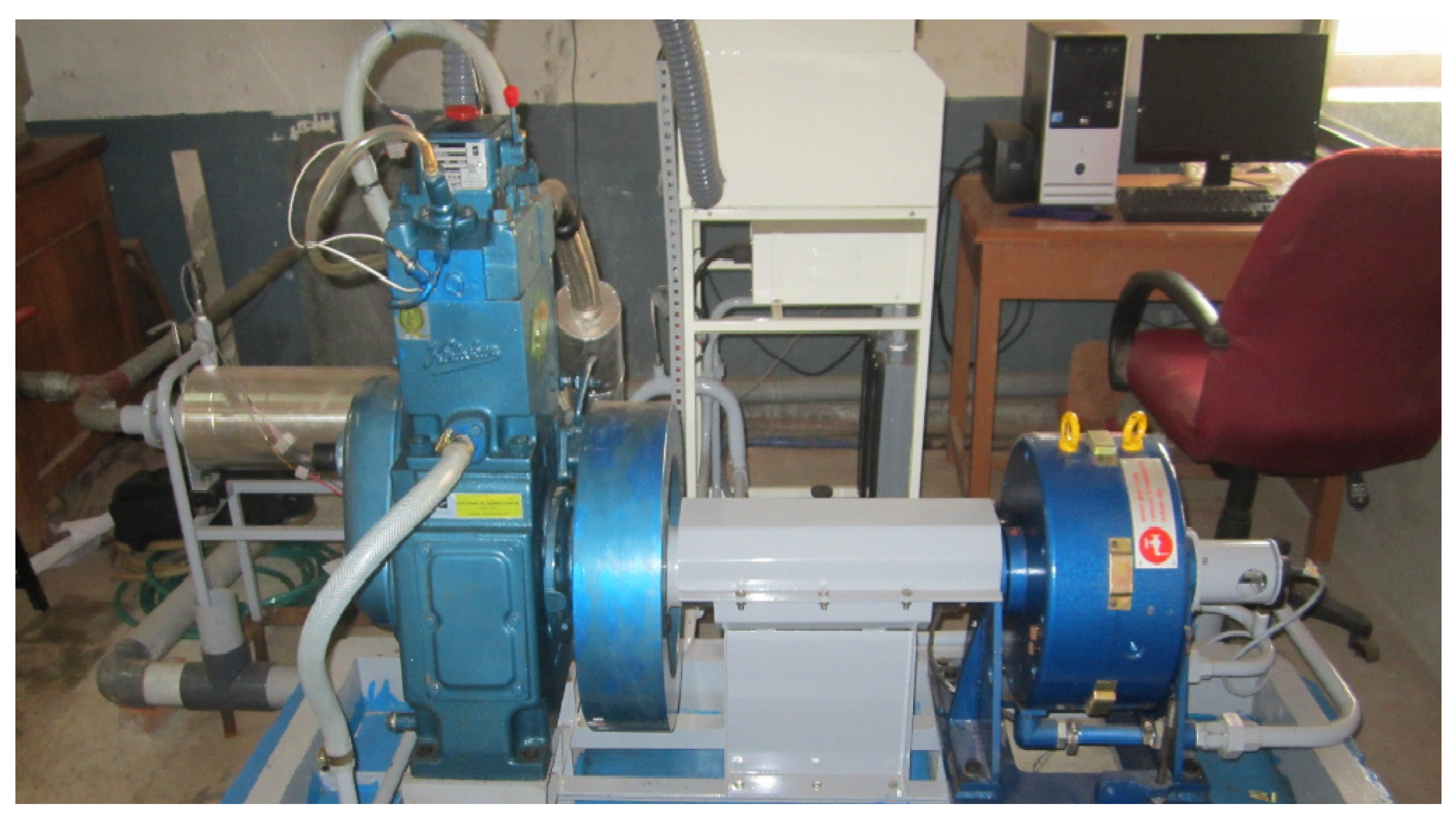



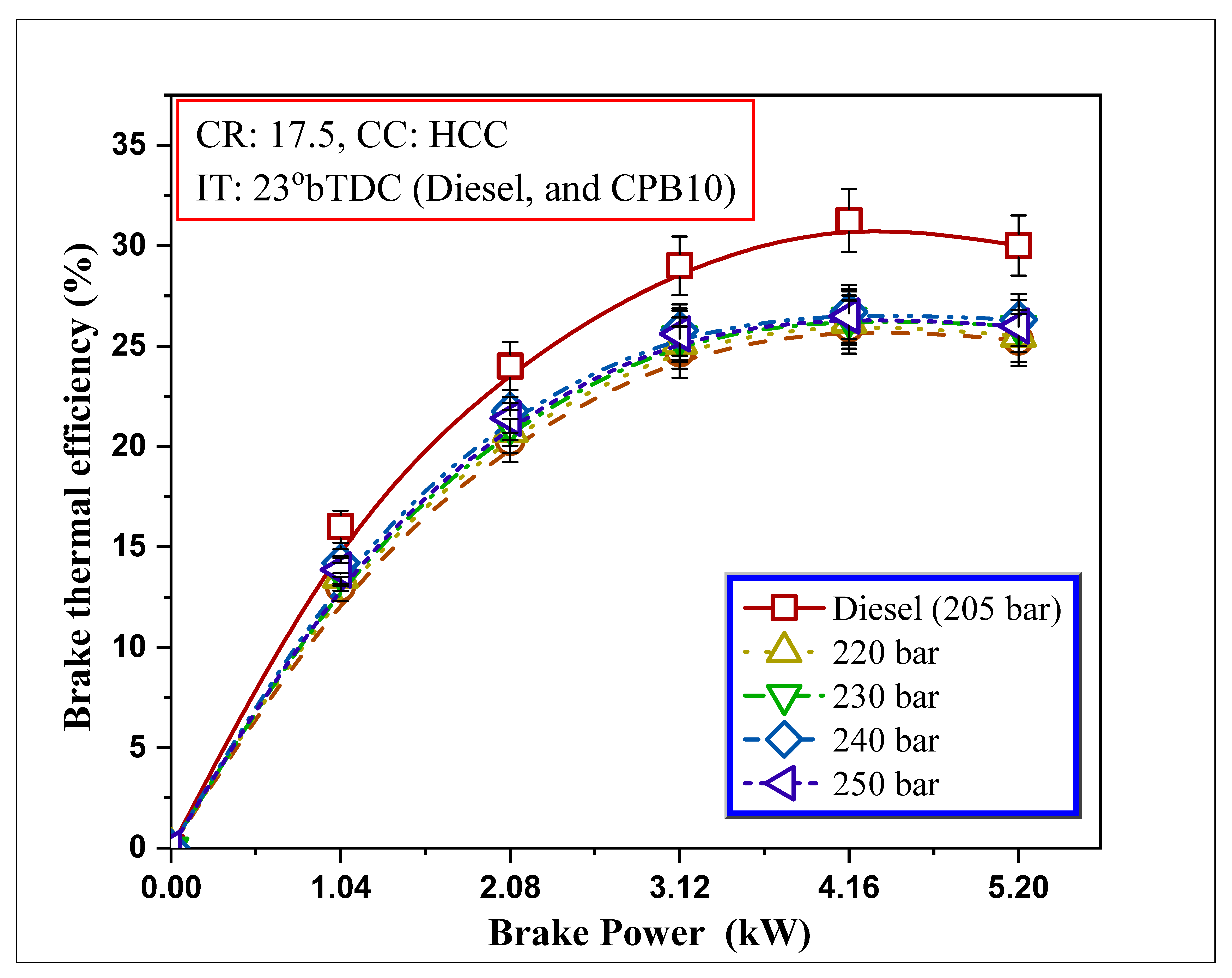

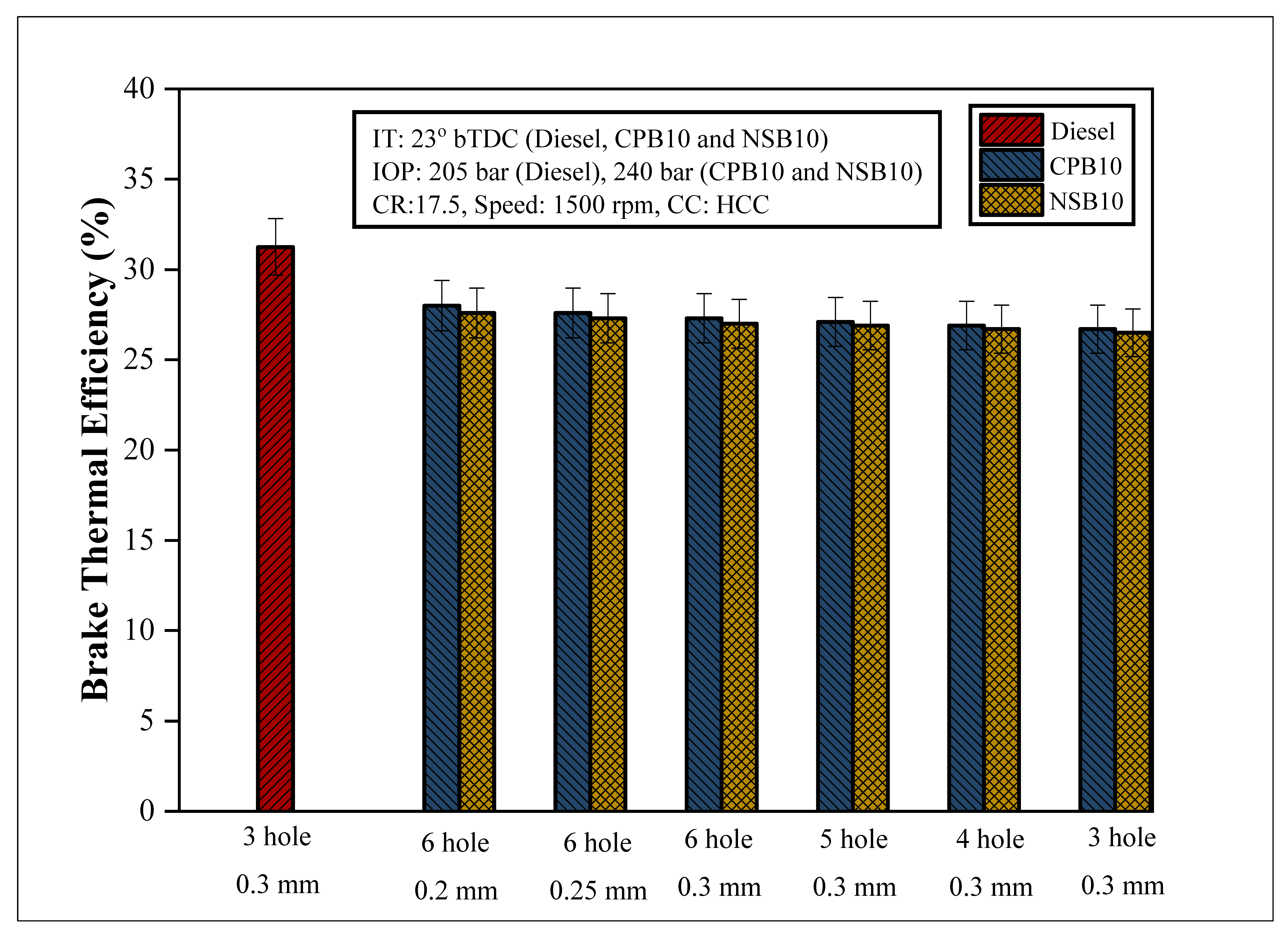


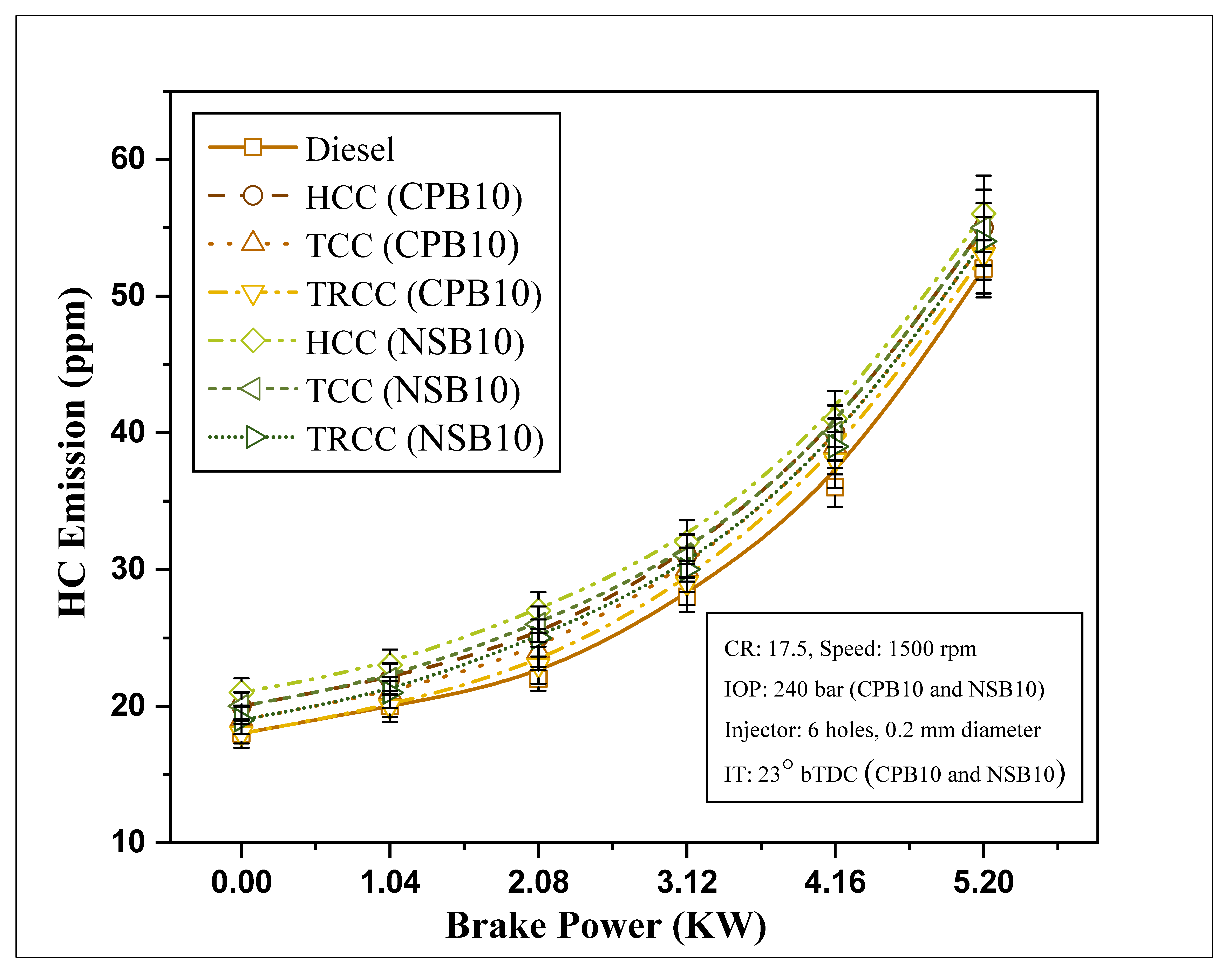
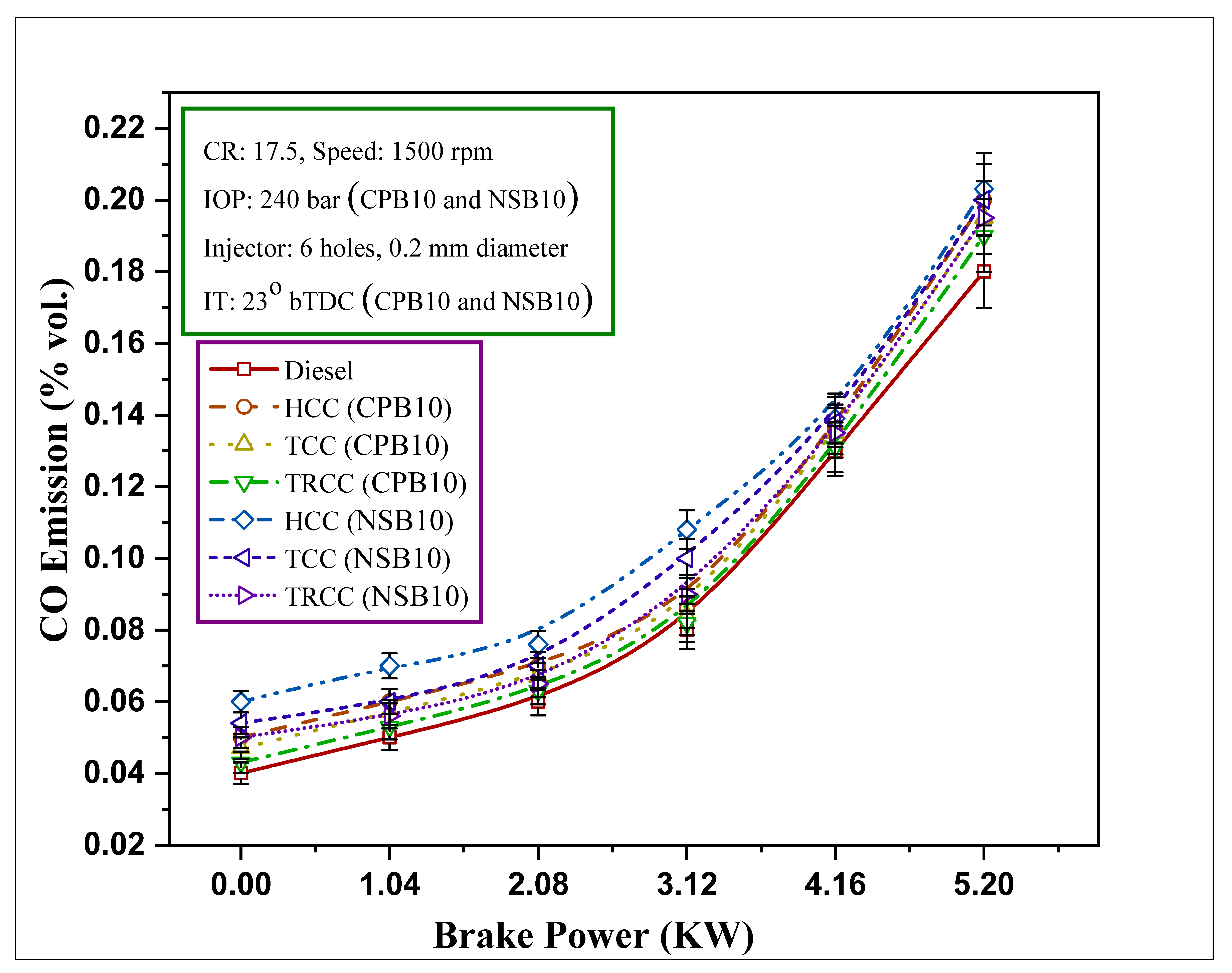




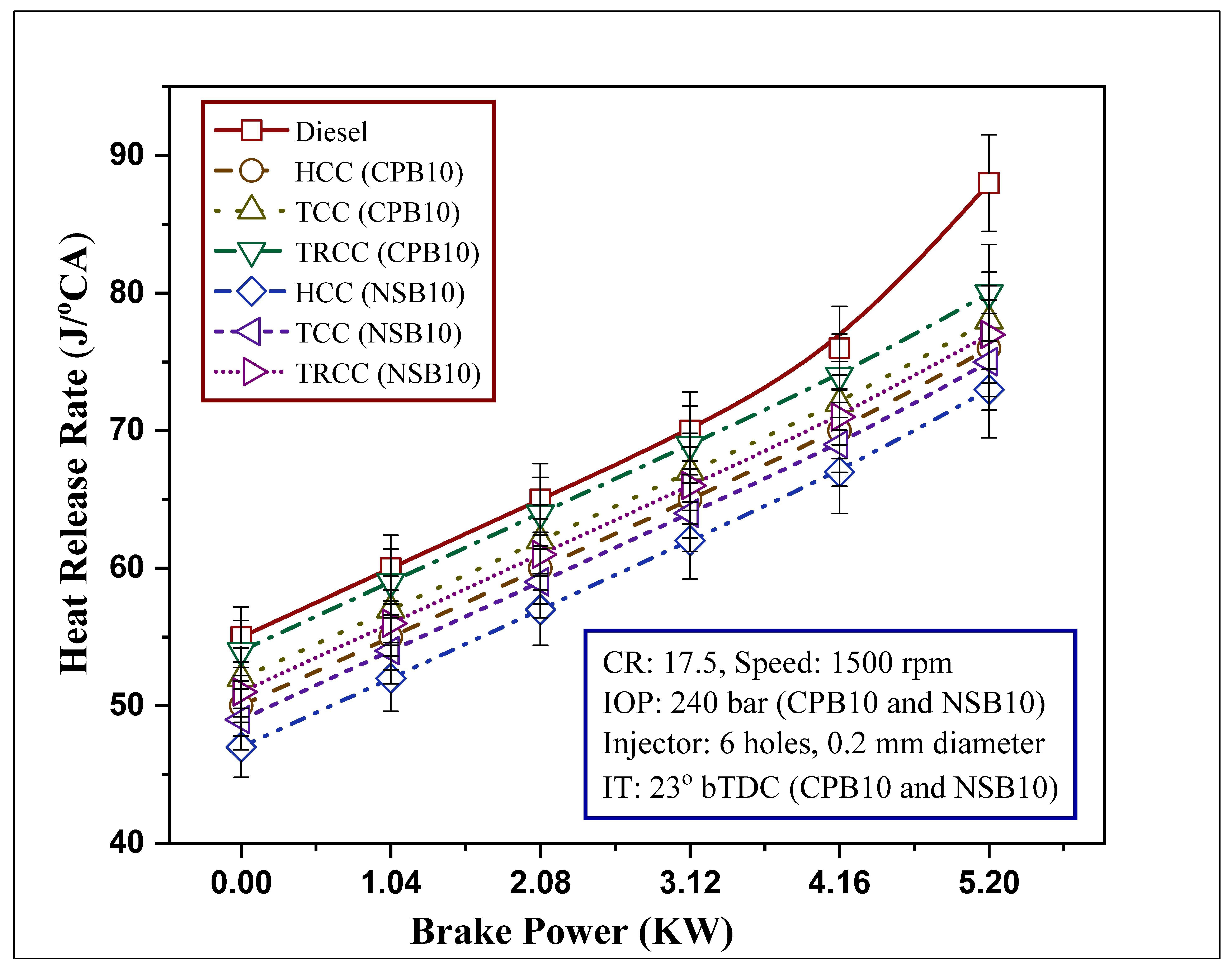
| Sl. No. | Parameters | Specification |
|---|---|---|
| 1 | Type | TV1 (Kirlosker make) |
| 2 | Nozzle opening pressure | 200–250 bar |
| 3 | Number of cylinders | Single cylinder |
| 4 | Number of strokes | Four stroke |
| 5 | Cylinder diameter (bore) | 87.5 mm |
| 6 | Rated power | 5.2 kW (7 HP) at 1500 rpm |
| 7 | Compression ratio | 17.5:1 |
| 8 | Stroke length | 110 mm |
| Measured Variable | Accuracy (±) |
|---|---|
| Load, N | 0.1 |
| Engine speed, rpm | 2 |
| Temperature, °C | 2 |
| Measured variable | Uncertainty (%) |
| Smoke | ±1.2 |
| HC | ±1.2 |
| CO | ±2.4 |
| NOx | ±5 |
| Calculated parameters | Uncertainty (%) |
| BTE, (%) | ±1.3 |
| Fuel Properties | NSB10 | CPB10 | Diesel |
|---|---|---|---|
| Calorific value (kJ/kg) | 44,890 | 44,904 | 45,369 |
| At 40 °C, Kinematic viscosity (mm2/s) | 3.655 | 3.6568 | 3.6056 |
| At 40 °C, Dynamic viscosity (mPa.s) | 3.0535 | 3.0636 | 3.0095 |
| Flash point (°C) | 85.7 | 87.6 | 81.5 |
| At 40 °C, Density (g/cc) | 0.8441 | 0.8377 | 0.8347 |
| At 110 °C, Oxidation stability(h) | 10.25 | 4.98 | N/R |
| CFPP (°C) | 7 | 5 | 0 |
| Cloud point (°C) | 7 | 7 | 7 |
Publisher’s Note: MDPI stays neutral with regard to jurisdictional claims in published maps and institutional affiliations. |
© 2021 by the authors. Licensee MDPI, Basel, Switzerland. This article is an open access article distributed under the terms and conditions of the Creative Commons Attribution (CC BY) license (https://creativecommons.org/licenses/by/4.0/).
Share and Cite
Khan, T.M.Y.; Badruddin, I.A.; Soudagar, M.E.M.; Khandal, S.V.; Kamangar, S.; Mokashi, I.; Mujtaba, M.A.; Hossain, N. Biodiesel Production Using Modified Direct Transesterification by Sequential Use of Acid-Base Catalysis and Performance Evaluation of Diesel Engine Using Various Blends. Sustainability 2021, 13, 9731. https://doi.org/10.3390/su13179731
Khan TMY, Badruddin IA, Soudagar MEM, Khandal SV, Kamangar S, Mokashi I, Mujtaba MA, Hossain N. Biodiesel Production Using Modified Direct Transesterification by Sequential Use of Acid-Base Catalysis and Performance Evaluation of Diesel Engine Using Various Blends. Sustainability. 2021; 13(17):9731. https://doi.org/10.3390/su13179731
Chicago/Turabian StyleKhan, T. M. Yunus, Irfan Anjum Badruddin, Manzoore Elahi M. Soudagar, Sanjeev V. Khandal, Sarfaraz Kamangar, Imran Mokashi, M. A. Mujtaba, and Nazia Hossain. 2021. "Biodiesel Production Using Modified Direct Transesterification by Sequential Use of Acid-Base Catalysis and Performance Evaluation of Diesel Engine Using Various Blends" Sustainability 13, no. 17: 9731. https://doi.org/10.3390/su13179731
APA StyleKhan, T. M. Y., Badruddin, I. A., Soudagar, M. E. M., Khandal, S. V., Kamangar, S., Mokashi, I., Mujtaba, M. A., & Hossain, N. (2021). Biodiesel Production Using Modified Direct Transesterification by Sequential Use of Acid-Base Catalysis and Performance Evaluation of Diesel Engine Using Various Blends. Sustainability, 13(17), 9731. https://doi.org/10.3390/su13179731










